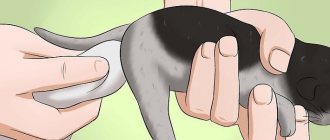Is it worth taming a wild kitten?
Sometimes on the street, in a gateway, near trash cans, people notice a cute but wild animal. Hungry and unwashed, it evokes pity. The decision comes to take the sufferer, but at the same time it is necessary to assess the condition of the animal:
- Wild cat. Born far from human habitation, never had contact with people.
- Semi-wild animal. Lives near houses, sees two-legged creatures, eats what it finds.
- Wild pet. He lived with a family and, due to circumstances, was thrown into the big world, where he himself had to take care of survival.
It is not so easy for a homeless child to get used to human habitation
Fortunately, any kitten can be tamed, and it's just a matter of time and patience. They only tame a homeless person if they want to take him home under permanent care.
Important! Whether to adopt a street kitten into a family is an individual decision.
First steps
Experienced animal lovers are sure that raising a kitten from the street is difficult, but possible. The main thing is to follow simple rules. It is important to understand that changing behavior takes a lot of time. Therefore, you need to be patient. Before you think about how to tame a wild kitten from the street, figure out whether you need it. The difference between pets is that they are people-oriented. Cubs, seeing a person from birth, feeling his smell, get used to trusting and reacting positively to the one who caresses and feeds them. Street animals, without an owner, gradually forget about trust and love for people, and therefore begin to react aggressively. Therefore, when seeing stray animals on the street, the first thing a person asks himself is: is it possible to tame a wild kitten at home, will it not spoil furniture and shit?
Why does a cat not want to be held?
Animal lovers assume that a stray kitten will happily go to live in a warm home. And then they become disappointed by the kitten’s reluctance to be held and caressed.
How to accustom a kitten to your hands: reasons for fear and methods of training
In fact, animals that are feral or have just been taken into the home are wary of new owners. They are frightened by unusual surroundings and smells. Some individuals, due to their independent nature, do not want communication. And a stern, fearful or withdrawn disposition completely prevents contact with people.
Attention! Character is the main reason why a kitten does not become an affectionate couch potato and does not run to your arms at the first call.
Breed also plays a role - lop-eared individuals and British species do not like tactile contact. Affectionate kittens: Sphynx, Russian Blue, Maine Coon.
Other reasons why a cat won’t be picked up:
- Distracted by more interesting things.
- I don’t like the smell from the owner - cats do not accept alcohol, spices, citrus fruits, or the scents of hygiene products.
- Relives past grievances.
- Afraid of heights and sharp sounds.
- Does not recognize other family members.
- Children, in a fit of tenderness, squeeze the animal and cause inconvenience.
Cats do not like the smell of washing powder, they are vindictive, so they often fail to pick them up.
An untamed cat prefers street company
Tray training
This problem is faced not only by those who picked up a kitten on the street. Animal sellers often claim that babies are toilet trained. But often this is not true. We have to get down to business ourselves and teach the baby one of the most necessary skills for living in an apartment.
Important! Moving or a new place of residence is stressful for an animal. Therefore, after such events, small and even adult individuals may experience problems going to the toilet. But after they get used to it, normal urination patterns will be restored.
During the process of training a pet, it is advisable that the kitten is always under the supervision of its owners. Observation will minimize the likelihood of puddles appearing in inappropriate places. Every successful trip to the litter tray requires praise and petting.
A successful trip to the litter box should be encouraged
Instructions for kittens
The tray should have a small side, since a small kitten will not be able to climb into a high toilet. Use clean water to rinse the container. If a fragrance is used, the smell should be subtle. To make the task easier, you need to soak a piece of cloth or paper in the urine of this kitten and put it in the tray. Then the baby will follow his scent. To toilet train a kitten, you can use special products that are sold in pet stores.
Tool for training a cat to use the tray
Determining that a kitten wants to go to the toilet is quite simple: it starts to fidget and loses its calm. At this point it needs to be moved to the tray. To better make it clear that an unfamiliar object is intended for bowel movements, you can scratch the surface of the tray with your finger. When urination or bowel movements begin, talk to the kitten in a gentle tone, thereby encouraging its correct actions.
The baby should be carried to the tray every time after waking up or eating. Having planted it in the tray, you need to make sure that it makes raking movements in the filler.
Attention! You can read more about the types of cat litter here.
Video - How to train a kitten to use a litter tray
Instructions for an adult cat
Problems may arise with an older cat. Here are the rules that will help you change your habits. The best place for the tray is a bathroom, toilet room, or insulated balcony. But no matter where the owner places the toilet, it is necessary to ensure constant access to it for the pet, especially if he is often left at home alone.
It is more difficult to train an adult cat to use a litter box.
If the cat lived outside before, then it is accustomed to the open space. Therefore, the tray must be large enough. Veterinarians recommend trays with high sides for adult cats so that the litter does not spill on the floor when it is raked after bowel movements or bladder. An alternative option is a toilet house.
Closed toilet house
This is interesting. A common myth is that females are easier to toilet train. However, they are more capricious and choose the place for the toilet themselves.
Usually, animals themselves intuitively understand the purpose of the structure with filler. But if this does not happen, you need to make it clear where to relieve yourself. There are several options. When the cat chooses a place to defecate, you need to quickly place a tray under it, stroke it and move away. It may be that the animal will run away. But it needs to be returned to its place and the action repeated until the process comes to its logical conclusion.
Attention! For an outdoor cat, for the first time, soil is poured instead of litter - it smells familiar.
For wild cats, you can try a lawn toilet
The smell of her urine will also guide your cat. To do this, as in the case of a kitten, a piece of cloth or paper soaked in urine is thrown into the tray.
Reasons for refusing a tray
Refusal to relieve yourself in a specified place can be provoked not only by the stubbornness of the animal, but also by other reasons:
- health problems;
- inconvenient tray format or size;
- choosing the wrong place;
- untimely cleaning of the toilet;
- the need to share a tray with another pet.
If the owner tries, the cat will sooner or later get used to its new toilet and stop shitting anywhere.
Each pet gets a separate tray
Surface treatment products for urine odor
But in case of failure, you cannot scold, much less beat, your pet - he may get scared, and such a measure will not bring any benefit. The area itself is treated with anti-urine odor products.
If a kitten makes a puddle, it should not be beaten or scolded.
Table 1. Home remedies for urine odor.
| Product name | Note |
| Weak solution of potassium permanganate | It can stain the surface; before use, carry out a test on an inconspicuous area of the surface of the floor, furniture, etc. |
| Vinegar diluted with water in a ratio of 1 to 3 | Does not stain surfaces |
| Lemon juice | Cats cannot tolerate the smell of citrus fruits and will avoid areas treated with juice. |
| Aqueous solution of iodine (10 drops per 1 liter of water) | Carefully! Paints surfaces |
| Vodka (spray from a spray bottle) | Cats can't stand the smell of vodka |
The industry produces a lot of products to remove the smell of cat urine. This:
- Urine-off Cat & Kitten or Multi-Pet;
- Arm&Hammer;
- DezoSan;
- OdorGone;
- Simple Solution Stain and Odor Remover and others.
Video - Checking traditional methods of getting rid of urine odor
How to tame a wild street cat
I want to take the pathetic tailed one home, warm it up and feed it. But reciprocal gratitude will not follow soon. How to tame a stray wild kitten is a task for those who are patient.
Do not use force
Snot in a kitten, cat and cat: how to treat it
First, a street resident is caught using homemade traps or containers for carrying animals. But it's important to put tasty treats in them. Cats go for the pleasant aroma of food.
You can show dexterity and catch the stray with your hands. But violence will work against the future owner. The kitten will not appreciate good intentions and will resist and scratch.
At home, the getting to know each other stage begins. The owners are careful and show friendliness. As soon as the kitten is released into the apartment, they let it run wherever it wants. But it is better that the space is limited: a separate room or bathroom. The pet will hide in a corner and hide.
First, they find out his mood - place his hand above the cat’s head. If he allows himself to be touched, he will begin to poke his muzzle into your palm and rub himself against your hand. Then the fluffy one is lightly stroked. After that they leave it alone.
Attention! You should not look the cat straight in the eye. At first, it is better to lower your gaze and turn away slightly.
They bring delicious food to the next meeting. You can try to pick up the animal and check its reaction. If it hisses and worries, stop.
Contact and adaptation
Coca is gradually accustomed to tactile relationships. They place their hand on the floor next to her. In the palm of your hand lies a treat or an interesting thing that will intrigue the student. When he approaches, stroke his fur.
When the cat gets used to the owner, this will immediately become noticeable in its behavior
You need to tame it at the same time, the cat will quickly get used to it. The first attempts are made twice a day, then the moments of contact are increased. At the same time, they show respect for the new tenant - they knock on the door, talk kindly.
Soon the animal will begin to rub against its owner's legs. Then they sit in a chair and encourage the pet to jump onto their lap. When he does this, gently limit his movements, stroking him, and make him sit more comfortably.
Smells
A good way to win over a wild cat is to create pleasant scents around you. What pets like to smell:
- Catnip – brings the feline class into a playful state.
- Olives improve the mood of animals. They begin to rub against their owner's legs and willingly go into their arms.
- Honeysuckle is relaxing and calming for cats, as are lavender and thyme. They are used to relieve aggression and insomnia in pets. But you can’t eat the berries - they are poisonous.
Cats love floral and fruity (peach, strawberry) scents. Smells help domesticate animals and attract them to their owners, especially at the taming stage.
How to catch a cat if it is afraid of you?
There are situations when owners are faced with a pet’s fear. Seeing a person, the animal runs to the side, hides under furniture, shows aggression, especially if they want to get it out from under the sofa - you can hear hissing and scratching.
There may be several reasons for fear: the use of brute force in games, heredity, sad experiences of living on the street, etc. In this case, it is important to abandon punishment, forced games with the cat, and loud conversations. On the recommendation of a doctor, you can give your pet a special sedative.
To catch a cat, you need to establish a trusting relationship with it. You can try to lure him out from under the sofa with your favorite treat. There is another way: wait until the cat calms down and comes on its own. After this, it is important to pet her, treat her to something tasty and praise her for the right decision.
Be sure to read:
A cat shits anywhere: reasons and what to do
Features of training pedigree cats
Purebred cats are taken from friends, pet stores, nurseries and shelters. They teach rules of behavior consistently and patiently.
Hemorrhoids in cats, cats and kittens: how to treat
First, the cat is given a nickname, short and sonorous. They repeat it often and kindly. When he responds and approaches, he is rewarded with a treat. They constantly talk to the ward. Cats understand not words, but intonation. They react sensitively to the mood of the owner and understand the mood by tone.
At the same time, they are taught to behave correctly. One command is a ban, then, when the cat understands and begins to comply, another useful habit. The kitten is given an understanding of what it should not do: bite its owner, scratch furniture. Forbidden "Ugh!" and “You can’t!”, accompanied by the clapping of palms, the pupils understand quickly.
Important! The animal is rewarded for following commands, and punished for misdeeds. But immediately, and not in a few hours, the cat will not understand and will harbor a grudge. Beatings are unacceptable.
Pets are taught not to climb on the table. They are taught to eat in one place and from the same utensils, to go to the toilet using a tray or toilet. Poking a kitten's nose into its puddle is inhumane and pointless. It is better to patiently lead him to the right place, stay with him, and encourage him after the right actions.
Toys for pets are important in the process of getting used to a new place
How long will it take to train
Individuals are taken into foster care for up to 12 weeks, then the process proceeds without complications, because cats are pets by definition. Up to 4 weeks, kittens are of suckling age. You cannot take them away from their mother. They take them into the house together with their parents, or wait until they grow up. This is the easiest animal to tame. In a day or two, the cat will be caressed and walk on your hand.
Important! Old cats are also taken into the house; they can be tamed, but it will take more time.
If the cat has lived outside for several months, taming will take longer. The animal may be frightened by unkind people, so it will avoid contact with the owner for a long time.
What not to do when catching and taming cats
When they want to catch a favorite cat, they do not use blankets, bags, or sacks. This will scare the animal and cause aggression. Scratching is dangerous due to the threat of the rabies virus and other infections.
How to accustom a cat to you and what not to do:
- Welcome a homeless person if there are no plans to take him in for permanent residence.
- Looking into a cat's eyes - he perceives it as a threat.
- Touch and pick up homeless children without gloves.
- Overfeed your pet at home.
- Forcing a cat to sit on your hands or lap when he is not yet ready. This will slow down socialization.
If you want to establish a trusting relationship with your cat and experience mutual joy, you should never hit him.
Taming
When the selected pet gets used to the house a little, you can begin to tame it. To begin with, you should place a bowl of food next to the secluded place where he sits out. At first, it is recommended to offer the kitten wet food - such food will most likely attract the attention of a hungry animal, and it will come out of hiding.
You should gradually move the bowl of food closer to the middle of the room in which the pet is hiding, forcing it to come out further and further. You can then offer food by placing it at arm's length.
When you manage to feed the kitten by hand, you can try to pet it, but without sudden movements, gently placing your hand on its back or muzzle.
Subscribe to our newsletter and get a free veterinary consultation
Thanks for subscribing!
How to adapt a cat to a new place of residence
Pets are considered members of the family. The moment when they are brought into the apartment for the first time is exciting for the owners, equal to stress for the cats.
The adaptation period will be quick if you take care of the necessary things:
- Feed. They choose the usual one that was fed by the previous owners. The nursery clarifies the diet and norm.
- Tray with filler. It is better to take away cat accessories from the previous owners, or patiently accustom the pet to a new litter box.
- Litter. They bring it from the breeder and gradually accustom it to the new one.
- Scratching post. A necessary accessory if furniture and curtains are expensive.
- Toys. Busy with fussing, the kitten will survive the move easier and will quickly get used to the new home.
Toys are chosen in pet stores and consulted with a veterinarian. At first, attentive owners, establishing contact, play with the pet for a long time.
Punishment should not be cruel
Raising a street and feral kitten
When a kitten is caught without force, it is easier to tame it. Immediately after catching it, it is taken to a veterinary clinic. The doctor examines and gives recommendations. At home, the new resident is bathed and given anti-helminth medications. Later they are treated against external insects and quarantined for two weeks. This measure is necessary to avoid infecting other pets and owners.
A calm environment is created for the kitten. They are left alone with food and water. They come to visit, affectionately calling you by name. Entrance is preceded by a knock. How to accustom a cat to being handled is not a primary task. First, let the pet get used to the new smells.
If a cat presses his ears to his head and hisses, he is not ready for contact. With patience, they teach the ward the household rules: go to the toilet, eat and sleep in his own place. To quickly get in touch with you, use your favorite cat scents, which relax and calm the animal.
Important! The pet is taken out into the air in a carrier bag. A street tramp will run away at the first opportunity - you can’t let him out.
Catch a pet
Animal defenders often face the problem of catching animals. Since cats are afraid of people, it becomes difficult to catch them. At the sight of a person, the flock scatters. To catch kittens, you can use a baby blanket (or a piece of thick fabric) or a fish net.
It is important to quickly cover the kitten and take it to the apartment. Prepare him a box or a house - any shelter. It is better to place the toilet for a wild cat in a visible place. To begin with, use a very ordinary tray so that the animal can sniff it without hindrance. If possible, give your pet a separate room or lock him in the bathroom, this will help him feel more secure.
Veterinary service
A foundling is always dangerous. Ectoparasites can live on his skin: fleas, ticks, lice. The internal “residents” – helminths – are called endoparasites. Wherever there is a concentration of wild animals, viruses and insects are infested.
The homeless child is first bathed, the skin is treated with drops, sprays, and shampoos. Anti-worm tablets are given internally. Next, the veterinarian prescribes a comprehensive vaccination. The animal must be free from helminths, so vaccinations are done after quarantine and tests for the presence of worms. They are vaccinated against rabies, lichen, and calcivirus infection.
Taming a kitten, whether stray or from a breeder, is not difficult. Fluffy pets always live with people, so they easily get used to new living conditions. Patience, love and affection will turn an animal into a pet who will bring joy to the house.
First actions
When the pet is in the house, he needs to be given some time to get used to it in a dark corner. At first, you should not disturb him or touch him with your hands. But some procedures must be carried out almost immediately, without delay. First, you need to check your nose and eyes - discharge from them indicates the presence of infection. Secondly, you should wash the animal using a special shampoo for kittens to get rid of ectoparasites. Be prepared for the fact that the kitten is not accustomed to such procedures and therefore will bite and scratch.
The pet will need to be shown immediately to a veterinarian so that he can determine its age, take the necessary tests and advise on vaccination, feeding and care.











